Antibody data
- Antibody Data
- Antigen structure
- References [42]
- Comments [0]
- Validations
- Immunocytochemistry [2]
- Other assay [26]
Submit
Validation data
Reference
Comment
Report error
- Product number
- 44-621G - Provider product page

- Provider
- Invitrogen Antibodies
- Product name
- Phospho-AKT1 (Ser473) Monoclonal Antibody (14-6)
- Antibody type
- Monoclonal
- Antigen
- Synthetic peptide
- Description
- This product contains enough material for 10 mini-blots. The immunogenic sequence is conserved among multiple species including human, mouse, and rat in all three isoforms: Akt1, Akt2, and Akt3. Others species (100% homologous) have not been tested. Recommended positive controls include NIH-3T3 cells stimulated with PDGF and 3T3-L1 adipocytes stimulated with OSM and IFN-gamma.
- Reactivity
- Human, Mouse
- Host
- Rabbit
- Isotype
- IgG
- Antibody clone number
- 14-6
- Vial size
- 100 µL
- Concentration
- 0.5 mg/mL
- Storage
- -20°C
Submitted references The phosphatase and tensin homolog gene inserted between NP and P gene of recombinant New castle disease virus oncolytic effect test to glioblastoma cell and xenograft mouse model.
Downregulation of miR-375 contributes to ERBB2-mediated VEGFA overexpression in esophageal cancer.
D-Chiro-Inositol Regulates Insulin Signaling in Human Adipocytes.
Cardiac Protective Effect of Kirenol against Doxorubicin-Induced Cardiac Hypertrophy in H9c2 Cells through Nrf2 Signaling via PI3K/AKT Pathways.
MiR-133a-3p attenuates resistance of non-small cell lung cancer cells to gefitinib by targeting SPAG5.
The proprotein convertase furin inhibits IL-13-induced inflammation in airway smooth muscle by regulating integrin-associated signaling complexes.
Choline and nicotine increase glioblastoma cell proliferation by binding and activating α7- and α9- containing nicotinic receptors.
IGF1 does not overcome sexual dimorphism of body and muscle size in Mstn-/- mice.
A-769662 inhibits adipocyte glucose uptake in an AMPK-independent manner.
Implications of cell division cycle associated 4 on the Wilm's tumor cells viability via AKT/mTOR signaling pathway.
Inhibition of AMPK activity in response to insulin in adipocytes: involvement of AMPK pS485, PDEs, and cellular energy levels.
Phenotype transitions induced by mechanical stimuli in airway smooth muscle are regulated by differential interactions of parvin isoforms with paxillin and Akt.
Evidence for acupoint catgut embedding treatment and TRPV1 gene deletion increasing weight control in murine model.
Jejunal Insulin Signalling Is Increased in Morbidly Obese Subjects with High Insulin Resistance and Is Regulated by Insulin and Leptin.
Systematic Development and Optimization of Inhalable Pirfenidone Liposomes for Non-Small Cell Lung Cancer Treatment.
Neuroprotective Effects of Growth Hormone (GH) and Insulin-Like Growth Factor Type 1 (IGF-1) after Hypoxic-Ischemic Injury in Chicken Cerebellar Cell Cultures.
Kaempferol Inhibits Zearalenone-Induced Oxidative Stress and Apoptosis via the PI3K/Akt-Mediated Nrf2 Signaling Pathway: In Vitro and In Vivo Studies.
Phlpp1 is associated with human intervertebral disc degeneration and its deficiency promotes healing after needle puncture injury in mice.
Phylogenetically Defined Isoforms of Listeria monocytogenes Invasion Factor InlB Differently Activate Intracellular Signaling Pathways and Interact with the Receptor gC1q-R.
Ascites from ovarian cancer patients stimulates MUC16 mucin expression and secretion in human peritoneal mesothelial cells through an Akt-dependent pathway.
Visualization of lipid directed dynamics of perilipin 1 in human primary adipocytes.
Thermogenesis, fatty acid synthesis with oxidation, and inflammation in the brown adipose tissue of ob/ob (-/-) mice.
Differential effects of angiotensin receptor blockers on pancreatic islet remodelling and glucose homeostasis in diet-induced obese mice.
A rich medium-chain triacylglycerol diet benefits adiposity but has adverse effects on the markers of hepatic lipogenesis and beta-oxidation.
DMSO Represses Inflammatory Cytokine Production from Human Blood Cells and Reduces Autoimmune Arthritis.
Evidence for the involvement of the CXCL12 system in the adaptation of skeletal muscles to physical exercise.
Adverse effects of vitamin D deficiency on the Pi3k/Akt pathway and pancreatic islet morphology in diet-induced obese mice.
A high-fish-oil diet prevents adiposity and modulates white adipose tissue inflammation pathways in mice.
Ovarian cancer ascites enhance the migration of patient-derived peritoneal mesothelial cells via cMet pathway through HGF-dependent and -independent mechanisms.
p53 attenuates AKT signaling by modulating membrane phospholipid composition.
Ganitumab (AMG 479) inhibits IGF-II-dependent ovarian cancer growth and potentiates platinum-based chemotherapy.
Hematopoiesis and RAS-driven myeloid leukemia differentially require PI3K isoform p110α.
Noncovalent wild-type-sparing inhibitors of EGFR T790M.
PLC-γ and PI3K link cytokines to ERK activation in hematopoietic cells with normal and oncogenic Kras.
Protein phosphatase magnesium dependent 1A (PPM1A) plays a role in the differentiation and survival processes of nerve cells.
Widespread potential for growth-factor-driven resistance to anticancer kinase inhibitors.
Type I IFN receptor and the B cell antigen receptor regulate TLR7 responses via distinct molecular mechanisms.
The role of SHIP in the development and activation of mouse mucosal and connective tissue mast cells.
Neuregulin-1-mediated autocrine signaling underlies sensitivity to HER2 kinase inhibitors in a subset of human cancers.
The absence of caveolin-1 increases proliferation and anchorage- independent growth by a Rac-dependent, Erk-independent mechanism.
Deregulated NFATc1 activity transforms murine fibroblasts via an autocrine growth factor-mediated Stat3-dependent pathway.
Activation of Notch-mediated protective signaling in the myocardium.
Jang SH, Jung BK, An YH, Jang H
Virology journal 2022 Jan 29;19(1):21
Virology journal 2022 Jan 29;19(1):21
Downregulation of miR-375 contributes to ERBB2-mediated VEGFA overexpression in esophageal cancer.
Ren S, Tan X, Fu MZ, Ren S, Wu X, Chen T, Latham PS, Lin P, Man YG, Fu SW
Journal of Cancer 2021;12(23):7138-7146
Journal of Cancer 2021;12(23):7138-7146
D-Chiro-Inositol Regulates Insulin Signaling in Human Adipocytes.
Montt-Guevara MM, Finiguerra M, Marzi I, Fidecicchi T, Ferrari A, Genazzani AD, Simoncini T
Frontiers in endocrinology 2021;12:660815
Frontiers in endocrinology 2021;12:660815
Cardiac Protective Effect of Kirenol against Doxorubicin-Induced Cardiac Hypertrophy in H9c2 Cells through Nrf2 Signaling via PI3K/AKT Pathways.
Alzahrani AM, Rajendran P, Veeraraghavan VP, Hanieh H
International journal of molecular sciences 2021 Mar 23;22(6)
International journal of molecular sciences 2021 Mar 23;22(6)
MiR-133a-3p attenuates resistance of non-small cell lung cancer cells to gefitinib by targeting SPAG5.
Li Q, Wang Y, He J
Journal of clinical laboratory analysis 2021 Jul;35(7):e23853
Journal of clinical laboratory analysis 2021 Jul;35(7):e23853
The proprotein convertase furin inhibits IL-13-induced inflammation in airway smooth muscle by regulating integrin-associated signaling complexes.
Wu Y, Huang Y, Zhang W, Gunst SJ
American journal of physiology. Lung cellular and molecular physiology 2021 Jul 1;321(1):L102-L115
American journal of physiology. Lung cellular and molecular physiology 2021 Jul 1;321(1):L102-L115
Choline and nicotine increase glioblastoma cell proliferation by binding and activating α7- and α9- containing nicotinic receptors.
Pucci S, Fasoli F, Moretti M, Benfante R, Di Lascio S, Viani P, Daga A, Gordon TJ, McIntosh M, Zoli M, Clementi F, Gotti C
Pharmacological research 2021 Jan;163:105336
Pharmacological research 2021 Jan;163:105336
IGF1 does not overcome sexual dimorphism of body and muscle size in Mstn-/- mice.
Paul R, Whiteman K, Falconer SJ, Oldham JM, Jeanplong F, Matthews KG, Smith HK, Thomas M, Watson T, McMahon CD
The Journal of endocrinology 2021 Feb;248(2):207-220
The Journal of endocrinology 2021 Feb;248(2):207-220
A-769662 inhibits adipocyte glucose uptake in an AMPK-independent manner.
Kopietz F, Alshuweishi Y, Bijland S, Alghamdi F, Degerman E, Sakamoto K, Salt IP, Göransson O
The Biochemical journal 2021 Feb 12;478(3):633-646
The Biochemical journal 2021 Feb 12;478(3):633-646
Implications of cell division cycle associated 4 on the Wilm's tumor cells viability via AKT/mTOR signaling pathway.
Li S, Qin C, Chen Y, Wei D, Tan Z, Meng J
Renal failure 2021 Dec;43(1):1470-1478
Renal failure 2021 Dec;43(1):1470-1478
Inhibition of AMPK activity in response to insulin in adipocytes: involvement of AMPK pS485, PDEs, and cellular energy levels.
Kopietz F, Rupar K, Berggreen C, Säll J, Vertommen D, Degerman E, Rider MH, Göransson O
American journal of physiology. Endocrinology and metabolism 2020 Sep 1;319(3):E459-E471
American journal of physiology. Endocrinology and metabolism 2020 Sep 1;319(3):E459-E471
Phenotype transitions induced by mechanical stimuli in airway smooth muscle are regulated by differential interactions of parvin isoforms with paxillin and Akt.
Huang Y, Gunst SJ
American journal of physiology. Lung cellular and molecular physiology 2020 May 1;318(5):L1036-L1055
American journal of physiology. Lung cellular and molecular physiology 2020 May 1;318(5):L1036-L1055
Evidence for acupoint catgut embedding treatment and TRPV1 gene deletion increasing weight control in murine model.
Inprasit C, Huang YC, Lin YW
International journal of molecular medicine 2020 Mar;45(3):779-792
International journal of molecular medicine 2020 Mar;45(3):779-792
Jejunal Insulin Signalling Is Increased in Morbidly Obese Subjects with High Insulin Resistance and Is Regulated by Insulin and Leptin.
Gutierrez-Repiso C, Ho-Plagaro A, Santiago-Fernandez C, Garcia-Serrano S, Rodríguez-Pacheco F, Valdes S, Garrido-Sanchez L, Rodríguez-Díaz C, López-Gómez C, Moreno-Ruiz FJ, Alcain-Martinez G, Gautier-Stein A, Mithieux G, Garcia-Fuentes E
Journal of clinical medicine 2020 Jan 10;9(1)
Journal of clinical medicine 2020 Jan 10;9(1)
Systematic Development and Optimization of Inhalable Pirfenidone Liposomes for Non-Small Cell Lung Cancer Treatment.
Parvathaneni V, Kulkarni NS, Shukla SK, Farrales PT, Kunda NK, Muth A, Gupta V
Pharmaceutics 2020 Feb 28;12(3)
Pharmaceutics 2020 Feb 28;12(3)
Neuroprotective Effects of Growth Hormone (GH) and Insulin-Like Growth Factor Type 1 (IGF-1) after Hypoxic-Ischemic Injury in Chicken Cerebellar Cell Cultures.
Baltazar-Lara R, Ávila-Mendoza J, Martínez-Moreno CG, Carranza M, Pech-Pool S, Vázquez-Martínez O, Díaz-Muñoz M, Luna M, Arámburo C
International journal of molecular sciences 2020 Dec 29;22(1)
International journal of molecular sciences 2020 Dec 29;22(1)
Kaempferol Inhibits Zearalenone-Induced Oxidative Stress and Apoptosis via the PI3K/Akt-Mediated Nrf2 Signaling Pathway: In Vitro and In Vivo Studies.
Rajendran P, Ammar RB, Al-Saeedi FJ, Mohamed ME, ElNaggar MA, Al-Ramadan SY, Bekhet GM, Soliman AM
International journal of molecular sciences 2020 Dec 28;22(1)
International journal of molecular sciences 2020 Dec 28;22(1)
Phlpp1 is associated with human intervertebral disc degeneration and its deficiency promotes healing after needle puncture injury in mice.
Zhang C, Smith MP, Zhou GK, Lai A, Hoy RC, Mroz V, Torre OM, Laudier DM, Bradley EW, Westendorf JJ, Iatridis JC, Illien-Jünger S
Cell death & disease 2019 Oct 3;10(10):754
Cell death & disease 2019 Oct 3;10(10):754
Phylogenetically Defined Isoforms of Listeria monocytogenes Invasion Factor InlB Differently Activate Intracellular Signaling Pathways and Interact with the Receptor gC1q-R.
Chalenko Y, Kalinin E, Marchenkov V, Sysolyatina E, Surin A, Sobyanin K, Ermolaeva S
International journal of molecular sciences 2019 Aug 24;20(17)
International journal of molecular sciences 2019 Aug 24;20(17)
Ascites from ovarian cancer patients stimulates MUC16 mucin expression and secretion in human peritoneal mesothelial cells through an Akt-dependent pathway.
Matte I, Garde-Granger P, Bessette P, Piché A
BMC cancer 2019 Apr 30;19(1):406
BMC cancer 2019 Apr 30;19(1):406
Visualization of lipid directed dynamics of perilipin 1 in human primary adipocytes.
Hansen JS, de Maré S, Jones HA, Göransson O, Lindkvist-Petersson K
Scientific reports 2017 Nov 8;7(1):15011
Scientific reports 2017 Nov 8;7(1):15011
Thermogenesis, fatty acid synthesis with oxidation, and inflammation in the brown adipose tissue of ob/ob (-/-) mice.
Martins FF, Bargut TCL, Aguila MB, Mandarim-de-Lacerda CA
Annals of anatomy = Anatomischer Anzeiger : official organ of the Anatomische Gesellschaft 2017 Mar;210:44-51
Annals of anatomy = Anatomischer Anzeiger : official organ of the Anatomische Gesellschaft 2017 Mar;210:44-51
Differential effects of angiotensin receptor blockers on pancreatic islet remodelling and glucose homeostasis in diet-induced obese mice.
Graus-Nunes F, Marinho TS, Barbosa-da-Silva S, Aguila MB, Mandarim-de-Lacerda CA, Souza-Mello V
Molecular and cellular endocrinology 2017 Jan 5;439:54-64
Molecular and cellular endocrinology 2017 Jan 5;439:54-64
A rich medium-chain triacylglycerol diet benefits adiposity but has adverse effects on the markers of hepatic lipogenesis and beta-oxidation.
Chamma CM, Bargut TC, Mandarim-de-Lacerda CA, Aguila MB
Food & function 2017 Feb 22;8(2):778-787
Food & function 2017 Feb 22;8(2):778-787
DMSO Represses Inflammatory Cytokine Production from Human Blood Cells and Reduces Autoimmune Arthritis.
Elisia I, Nakamura H, Lam V, Hofs E, Cederberg R, Cait J, Hughes MR, Lee L, Jia W, Adomat HH, Guns ES, McNagny KM, Samudio I, Krystal G
PloS one 2016;11(3):e0152538
PloS one 2016;11(3):e0152538
Evidence for the involvement of the CXCL12 system in the adaptation of skeletal muscles to physical exercise.
Puchert M, Adams V, Linke A, Engele J
Cellular signalling 2016 Sep;28(9):1205-1215
Cellular signalling 2016 Sep;28(9):1205-1215
Adverse effects of vitamin D deficiency on the Pi3k/Akt pathway and pancreatic islet morphology in diet-induced obese mice.
Borges CC, Salles AF, Bringhenti I, Souza-Mello V, Mandarim-de-Lacerda CA, Aguila MB
Molecular nutrition & food research 2016 Feb;60(2):346-57
Molecular nutrition & food research 2016 Feb;60(2):346-57
A high-fish-oil diet prevents adiposity and modulates white adipose tissue inflammation pathways in mice.
Bargut TC, Mandarim-de-Lacerda CA, Aguila MB
The Journal of nutritional biochemistry 2015 Sep;26(9):960-9
The Journal of nutritional biochemistry 2015 Sep;26(9):960-9
Ovarian cancer ascites enhance the migration of patient-derived peritoneal mesothelial cells via cMet pathway through HGF-dependent and -independent mechanisms.
Matte I, Lane D, Laplante C, Garde-Granger P, Rancourt C, Piché A
International journal of cancer 2015 Jul 15;137(2):289-98
International journal of cancer 2015 Jul 15;137(2):289-98
p53 attenuates AKT signaling by modulating membrane phospholipid composition.
Rueda-Rincon N, Bloch K, Derua R, Vyas R, Harms A, Hankemeier T, Khan NA, Dehairs J, Bagadi M, Binda MM, Waelkens E, Marine JC, Swinnen JV
Oncotarget 2015 Aug 28;6(25):21240-54
Oncotarget 2015 Aug 28;6(25):21240-54
Ganitumab (AMG 479) inhibits IGF-II-dependent ovarian cancer growth and potentiates platinum-based chemotherapy.
Beltran PJ, Calzone FJ, Mitchell P, Chung YA, Cajulis E, Moody G, Belmontes B, Li CM, Vonderfecht S, Velculescu VE, Yang G, Qi J, Slamon DJ, Konecny GE
Clinical cancer research : an official journal of the American Association for Cancer Research 2014 Jun 1;20(11):2947-58
Clinical cancer research : an official journal of the American Association for Cancer Research 2014 Jun 1;20(11):2947-58
Hematopoiesis and RAS-driven myeloid leukemia differentially require PI3K isoform p110α.
Gritsman K, Yuzugullu H, Von T, Yan H, Clayton L, Fritsch C, Maira SM, Hollingworth G, Choi C, Khandan T, Paktinat M, Okabe RO, Roberts TM, Zhao JJ
The Journal of clinical investigation 2014 Apr;124(4):1794-809
The Journal of clinical investigation 2014 Apr;124(4):1794-809
Noncovalent wild-type-sparing inhibitors of EGFR T790M.
Lee HJ, Schaefer G, Heffron TP, Shao L, Ye X, Sideris S, Malek S, Chan E, Merchant M, La H, Ubhayakar S, Yauch RL, Pirazzoli V, Politi K, Settleman J
Cancer discovery 2013 Feb;3(2):168-81
Cancer discovery 2013 Feb;3(2):168-81
PLC-γ and PI3K link cytokines to ERK activation in hematopoietic cells with normal and oncogenic Kras.
Diaz-Flores E, Goldschmidt H, Depeille P, Ng V, Akutagawa J, Krisman K, Crone M, Burgess MR, Williams O, Houseman B, Shokat K, Sampath D, Bollag G, Roose JP, Braun BS, Shannon K
Science signaling 2013 Dec 3;6(304):ra105
Science signaling 2013 Dec 3;6(304):ra105
Protein phosphatase magnesium dependent 1A (PPM1A) plays a role in the differentiation and survival processes of nerve cells.
Shohat M, Ben-Meir D, Lavi S
PloS one 2012;7(2):e32438
PloS one 2012;7(2):e32438
Widespread potential for growth-factor-driven resistance to anticancer kinase inhibitors.
Wilson TR, Fridlyand J, Yan Y, Penuel E, Burton L, Chan E, Peng J, Lin E, Wang Y, Sosman J, Ribas A, Li J, Moffat J, Sutherlin DP, Koeppen H, Merchant M, Neve R, Settleman J
Nature 2012 Jul 26;487(7408):505-9
Nature 2012 Jul 26;487(7408):505-9
Type I IFN receptor and the B cell antigen receptor regulate TLR7 responses via distinct molecular mechanisms.
Poovassery JS, Bishop GA
Journal of immunology (Baltimore, Md. : 1950) 2012 Aug 15;189(4):1757-64
Journal of immunology (Baltimore, Md. : 1950) 2012 Aug 15;189(4):1757-64
The role of SHIP in the development and activation of mouse mucosal and connective tissue mast cells.
Ruschmann J, Antignano F, Lam V, Snyder K, Kim C, Essak M, Zhang A, Lin AH, Mali RS, Kapur R, Krystal G
Journal of immunology (Baltimore, Md. : 1950) 2012 Apr 15;188(8):3839-50
Journal of immunology (Baltimore, Md. : 1950) 2012 Apr 15;188(8):3839-50
Neuregulin-1-mediated autocrine signaling underlies sensitivity to HER2 kinase inhibitors in a subset of human cancers.
Wilson TR, Lee DY, Berry L, Shames DS, Settleman J
Cancer cell 2011 Aug 16;20(2):158-72
Cancer cell 2011 Aug 16;20(2):158-72
The absence of caveolin-1 increases proliferation and anchorage- independent growth by a Rac-dependent, Erk-independent mechanism.
Cerezo A, Guadamillas MC, Goetz JG, Sánchez-Perales S, Klein E, Assoian RK, del Pozo MA
Molecular and cellular biology 2009 Sep;29(18):5046-59
Molecular and cellular biology 2009 Sep;29(18):5046-59
Deregulated NFATc1 activity transforms murine fibroblasts via an autocrine growth factor-mediated Stat3-dependent pathway.
Lagunas L, Clipstone NA
Journal of cellular biochemistry 2009 Sep 1;108(1):237-48
Journal of cellular biochemistry 2009 Sep 1;108(1):237-48
Activation of Notch-mediated protective signaling in the myocardium.
Gude NA, Emmanuel G, Wu W, Cottage CT, Fischer K, Quijada P, Muraski JA, Alvarez R, Rubio M, Schaefer E, Sussman MA
Circulation research 2008 May 9;102(9):1025-35
Circulation research 2008 May 9;102(9):1025-35
No comments: Submit comment
Supportive validation
- Submitted by
- Invitrogen Antibodies (provider)
- Main image
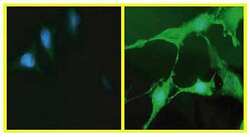
- Experimental details
- Immunofluorescent staining of serum-starved NIH3T3 cells, untreated (left) or treated with PDGF (right). Cells were fixed prior to immunostaining with the Akt (pS473) rabbit monoclonal antibody.
- Submitted by
- Invitrogen Antibodies (provider)
- Main image
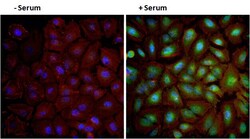
- Experimental details
- Immunofluorescent analysis of phospho-AKT pSer473 (green) in HeLa cells either serum starved overnight (left panel) or treated with 10% FBS (right panel) for 30 minutes. Formalin fixed cells were permeabilized with 0.1% Triton X-100 in TBS for 10 minutes at room temperature and blocked with 1% Blocker BSA (Product # 37525) for 15 minutes at room temperature. Cells were probed with a phospho-AKT pSer473 monoclonal antibody (Product # 44-621G) at a dilution of 1:100 for at least 1 hour at room temperature, washed with PBS, and incubated with DyLight 488 goat anti-rabbit IgG secondary antibody (Product # 35552) at a dilution of 1:400 for 30 minutes at room temperature. F-Actin (red) was stained with DyLight-554 Phalloidin (Product # 21834) and nuclei (blue) were stained with Hoechst 33342 dye (Product # 62249). Images were taken on a Thermo Scientific ArrayScan at 20X magnification.
Supportive validation
- Submitted by
- Invitrogen Antibodies (provider)
- Main image
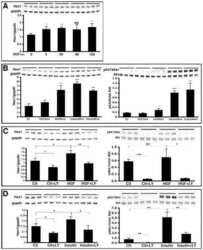
- Experimental details
- NULL
- Submitted by
- Invitrogen Antibodies (provider)
- Main image
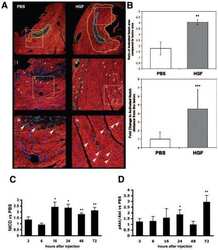
- Experimental details
- NULL
- Submitted by
- Invitrogen Antibodies (provider)
- Main image
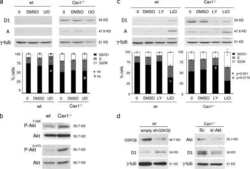
- Experimental details
- NULL
- Submitted by
- Invitrogen Antibodies (provider)
- Main image
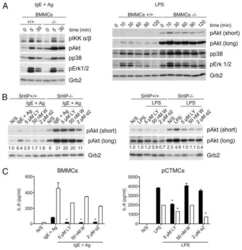
- Experimental details
- NULL
- Submitted by
- Invitrogen Antibodies (provider)
- Main image
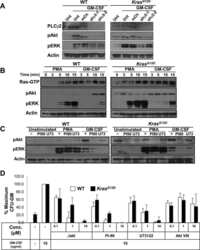
- Experimental details
- NULL
- Submitted by
- Invitrogen Antibodies (provider)
- Main image
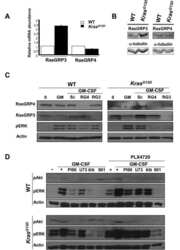
- Experimental details
- NULL
- Submitted by
- Invitrogen Antibodies (provider)
- Main image
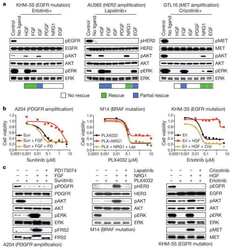
- Experimental details
- NULL
- Submitted by
- Invitrogen Antibodies (provider)
- Main image
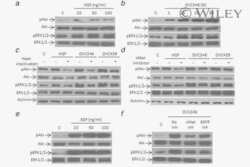
- Experimental details
- NULL
- Submitted by
- Invitrogen Antibodies (provider)
- Main image
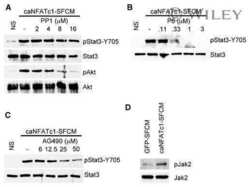
- Experimental details
- NULL
- Submitted by
- Invitrogen Antibodies (provider)
- Main image
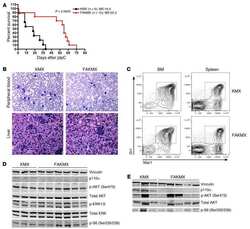
- Experimental details
- NULL
- Submitted by
- Invitrogen Antibodies (provider)
- Main image
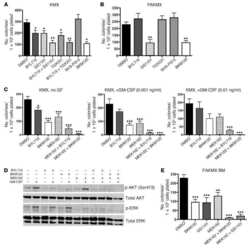
- Experimental details
- NULL
- Submitted by
- Invitrogen Antibodies (provider)
- Main image
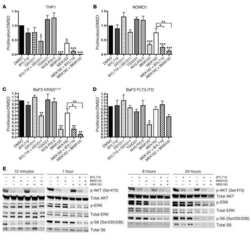
- Experimental details
- NULL
- Submitted by
- Invitrogen Antibodies (provider)
- Main image
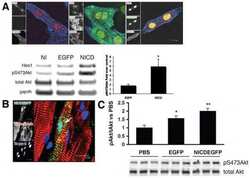
- Experimental details
- NULL
- Submitted by
- Invitrogen Antibodies (provider)
- Main image
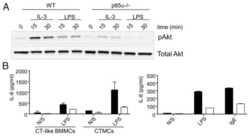
- Experimental details
- NULL
- Submitted by
- Invitrogen Antibodies (provider)
- Main image
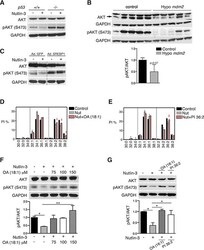
- Experimental details
- Figure 6 p53-mediated SCD repression attenuates AKT activation A. HCT116 p53 +/+ and p53 -/- cells were treated with 5 muM nutlin-3 for 72 h and pAKT (S473) and total AKT levels were assessed by western blotting. GAPDH was used as loading control. B. AKT and pAKT (S473) levels in tissues from hypo Mdm2 and control mice ( n = 5). The ratio pAKT/AKT is expressed relative to control, p = 0, 07, unpaired t test. C. Re-introduction of SREBP1 restores pAKT in nutlin-3-treated cells. HCT116 p53 +/+ cells were infected with an adenovirus encoding SREBP1c or empty virus. Four h after infection, cells were treated 5 muM nutlin-3 for 72 h. pAKT and total AKT levels were assessed by western blotting. The blot was cropped to show the conditions of interest. D and F. Oleic acid (OA) rescues the effect of p53 on pAKT by restoring phospholipid profiles. HCT116 cells were treated with OA (100 muM) in combination with 5 muM nutlin-3 (Nut). Phospholipid profiles are presented as described in the legend to Figure 1 . Representative blots of total AKT and pAKT (S473) are shown. The graph presents the average pAKT/AKT ratio of two independent samples. * p < 0.05, ** p < 0.01 by ANOVA. E and G. PI36:2 restores pAKT (S473) levels in nutlin-3-treated cells. HCT116 cells were treated with 5 muM nutlin-3 alone (Nut) or in combination with PI36:2 at 10 muM. After 72 h, cells pellets were collected for lipid or western blot analysis. Phospholipid profiles were presented as described in the legend to Figu
- Submitted by
- Invitrogen Antibodies (provider)
- Main image
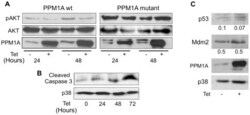
- Experimental details
- Figure 4 PPM1A overexpression affects cell cycle and survival markers. ( A ) PC6-3 cells overexpressing wt or mutant PPM1A were incubated with or without Tet for the indicated times. The cells were then harvested and lysed. Cell extracts were analyzed by western blot for levels of phosphorylated AKT, total AKT and PPM1A. Note that PPM1A mutant migrates faster than the wt on the gel ( [10] ) and that even in the absence of Tet there was a slight expression due to leakiness of PPM1A mutant. PPM1A wt cells were analyzed in the same manner for levels of ( B ) cleaved caspase 3 and p38. ( C ) PC6-3 cells overexpressing PPM1A were incubated with or without Tet for 24 hours. The cells were then harvested and lysed and cell extracts were analyzed for levels of p53, Mdm2, PPM1A and p38 by western blot. The numbers represent the ratio of p53/p38 (0.1, 0.07) and Mdm2/p38 levels (0.5, 0.5). The blots presented in ( A ) ( B ) and ( C ) are from representative experiments out of three performed.
- Submitted by
- Invitrogen Antibodies (provider)
- Main image
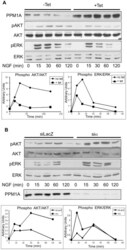
- Experimental details
- Figure 8 PPM1A over and underexpression and cell signaling during PC6-3 cells differentiation. ( A ) PPM1A wt cells were incubated with or without Tet for 24 hours and then NGF was added for the indicated times. ( B ) PC6-3 PPM1A knock-down cells and control cells were incubated with NGF for the indicated times. The cells were harvested and lysed. Cell extracts were analyzed by western blot using the indicated antibodies. Please note that the AKT and PPM1A panels in ( B ) are from different gels of the same experiments. The graphs represent quantification of the blots shown in ( A ) and ( B ) . The results shown are from representative experiments out of 3 independent that were performed.
- Submitted by
- Invitrogen Antibodies (provider)
- Main image
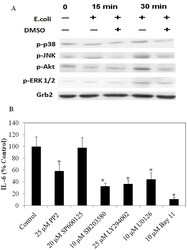
- Experimental details
- Fig 3 (A) The effect of DMSO on modulating the activation of cell signaling pathways in response to E . coli- stimulation of human blood monocytes. (B ) The effect of cell signaling inhibitors on IL-6 production form E . coli -challenged human monocytes. Inhibitor concentrations were chosen based on the lowest levels that markedly inhibited their pathways. *denotes significant inhibition (P
- Submitted by
- Invitrogen Antibodies (provider)
- Main image
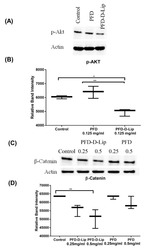
- Experimental details
- Figure 12 ( A ) Western blot representing inhibitory effect of treatments on expression of p-AKT protein in A549 cells. ( B) PFD-D-Lip significantly suppresses p-AKT expression in A549 cells. Cell lysates were prepared following 24-hour treatment of A549 cells with control, PFD and PFD-D-Lip (0.125 mg/mL) and were subjected to western blot analyses using antibodies against p-AKT and actin as a loading control, as indicated. ( C ) Western blot representing inhibitory effect of treatments on expression of beta-catenin protein in A549 cells. ( D ) PFD-D-Lip suppresses beta-catenin expression in A549 cells. Cell lysates were prepared following 72-hour treatment of A549 cells with control, PFD and PFD-D-Lip (0.25 and 0.5 mg/mL) and were subjected to western blot analyses using antibodies against beta-catenin and actin as a loading control, as indicated. The western blot densities were determined and plotted as relative band intensity against treatments. Western blot bands represent representative image of n = 3. Data represent mean +- SD ( n = 3). * p (alpha < 0.05), ** p (alpha < 0.01).
- Submitted by
- Invitrogen Antibodies (provider)
- Main image
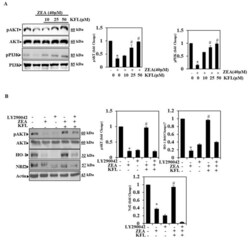
- Experimental details
- Figure 4 KFL triggers the PI3K/Akt pathway in ZEA-induced HepG2 cells. ( A ) Cells were treated with KFL (10, 25 and 50 uM) followed by ZEA (40 uM) for 24 h. After the treatment, whole-cell lysates were exposed to Western blotting with anti-pPI3K and anti-pAkt antibodies. Total PI3K and Akt levels were measured as loading controls. ( B ) Cells were pre-treated with a PI3K/Akt inhibitor (LY294002, 30 muM) for 2 h, followed by KFL (50 muM) and/or ZEA (40 muM) for 24 h. Western blot was performed to detect the pAkt, HO-1 and Nrf2 levels by anti-pAkt, anti-HO-1 and anti-Nrf2 abs. Data are represented as the mean +- SD of triplicate values ( n = 3), and * p < 0.05 represents noteworthy discrepancies compared with the control. # p < 0.05 represents significant variations compared with the ZEA alone and KFL with ZEA treatment groups.
- Submitted by
- Invitrogen Antibodies (provider)
- Main image
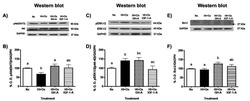
- Experimental details
- Figure 5 Effects of GH and IGF-1 treatments upon activation of the PI3K/Akt and MAPK/ERK1/2 signaling pathways and Bcl-2 expression after a hypoxic-ischemic injury in primary cerebellar cultures. Cells were maintained under either normoxic conditions (Nx), submitted to hypoxic-ischemic injury for 12 h (HI) and then reoxygenated for 24 h (HI + Ox), or treated with 1 nM GH or 40 nM IGF-1 after (denoted by A) 12h of HI, along the 24 h of reoxygenation period (HI + Ox GH-A; HI + Ox IGF-1-A). The upper panels show Western blots with specific immunoreactive bands corresponding to the following proteins: ( A ) total Akt (60 kDa) or pAkt (S473, 60 kDa); ( C ), ERK1/2 (44 kDa) or pERK1/2 (T202/Y204, 44 kDa); ( E ), Bcl-2 (27 kDa); and GAPDH (panels ( A , C , E ), 37 kDa) as loading control. ( B , D , F ) show densitometric (% O.D.) analysis of changes observed in ( A , C , E ). Bars represent the mean +- SEM, n = 5 independent experiments performed in duplicate. Groups with different letters are significantly different by one-way ANOVA and Tukey's post hoc test ( p < 0.01).
- Submitted by
- Invitrogen Antibodies (provider)
- Main image
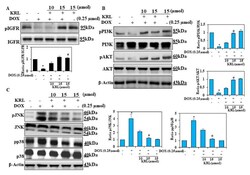
- Experimental details
- Figure 3 KRL enhances cell survival mechanism. H9c2 cells were cultured in serum-free media for 3 h, followed by treatment with KRL for 2 h before or after DOX treatment, respectively. ( A , B ) KRL activates the IGF1R-mediated survival pathway in H9c2 cells. The expression of p-IGF1R, PI3K, p-PI3K, AKT, and p-AKT was analyzed by Western blotting. beta-actin was used as the internal control. ( C ) Representative Western blots showing the changes in MAPK signaling proteins (pP38 and pJNK) in H9c2 cells. Data are represented as the mean +- SD of triplicate values ( n = 3) and * p < 0.05 represents significant variations compared with the control. # p < 0.05 represents significant variations as compared to DOX alone and KRL with DOX treatment groups.
- Submitted by
- Invitrogen Antibodies (provider)
- Main image
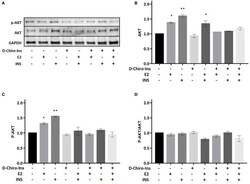
- Experimental details
- Figure 6 D-Chiro-Ins does not modulate the expression of Akt. Mature SGBS adipocytes cells were treated with D-Chiro-Ins 10 -8 M, E2 10 -9 M or INS 10 -7 M, and combinations for 24 h. Cell lysates were immunoblotted with an anti-Akt antibody, anti-p-Akt antibody, and anti-GAPDH antibody. (A) Panels show representative blot of Akt, p-Akt Ser473 and GAPDH. (B-D) Analysis of the relative expression level of Akt, p-Akt and the ratio p-Akt/Akt. The expression level of Akt and p-Akt was normalized with the protein amount of GAPDH, relative to the control. Values are presented as mean +- SEM of three independent experiments. Results were analyzed statistically by one-way RM ANOVA followed by Dunnett''s multiple comparisons test (*p < 0.05, **p < 0.01 versus control). D-Chiro-Ins, D-chiro-Inositol; E2, 17beta-estradiol, INS, insulin; GAPDH, glyceraldehyde-3-phosphate dehydrogenase.
- Submitted by
- Invitrogen Antibodies (provider)
- Main image
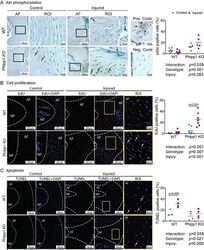
- Experimental details
- Fig. 4 Phlpp1-deletion (A) promoted Akt phosphorylation, (B) increased cell proliferation, and (C) decreased apoptosis 3 days after needle puncture injury. a ) Immunohistochemistry staining for pAkt demonstrated elevated Akt phosphorylation in the AF of Phlpp1 KO ( n = 5) compared to WT mice ( n = 7) at baseline. Injury further caused an increase of pAkt in Phlpp1 KO mice, but not in WT mice 3 days after needle puncture. ROI (region of interest) is the magnification of the region in the black boxes. Arrows indicate positive cells. Positive and negative controls were used for antibody validation. b ) EdU and c ) TUNEL assay of IVD sections 3 days after needle puncture. EdU-positive cells were increased in injured AF of Phlpp1 KO mice, compared to the other three groups ( n = 7 per group). TUNEL-positive cells were increased significantly in AF tissues of WT mice, but not in Phlpp1 KO mice 3 days after injury ( n = 4 per group). White dotted lines denote the border between the NP and AF compartments. Yellow boxes mark the magnified ROI. Arrows denote positive cells. Nuclei were stained with DAPI. Two-way ANOVAs were used to assess the effect of injury and genotype
- Submitted by
- Invitrogen Antibodies (provider)
- Main image
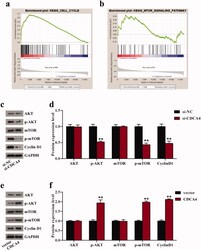
- Experimental details
- Figure 4. CDCA4 affected cell cycle and AKT/mTOR signaling pathway. (a-b) GSEA was utilized to identify the relative signaling pathway associated with high CDCA4 expression. (c-f) The effects of CDCA4-knockdown (c-d) and -overexpression (e-f) on the AKT/mTOR relative markers and Cyclin D1 protein were evaluated using western blot analysis. (d) Quantification of c. (f) Quantification of e. ** p < 0.01 vs . si-NC or vector group.
- Submitted by
- Invitrogen Antibodies (provider)
- Main image

- Experimental details
- Figure 2 Kinetics of Erk1/2 and Akt phosphorylation in the presence of idInlBs. A total of 100 ng/mL idInlBs were added to HEp-2 cells. Cells were lysed at pointed time points and probed with anti-phospho-Erk1/2 and anti-phospho-Akt antibodies. The curves show digitized data from three independent experiments. * p < 0.05.
 Explore
Explore Validate
Validate Learn
Learn Western blot
Western blot Immunocytochemistry
Immunocytochemistry